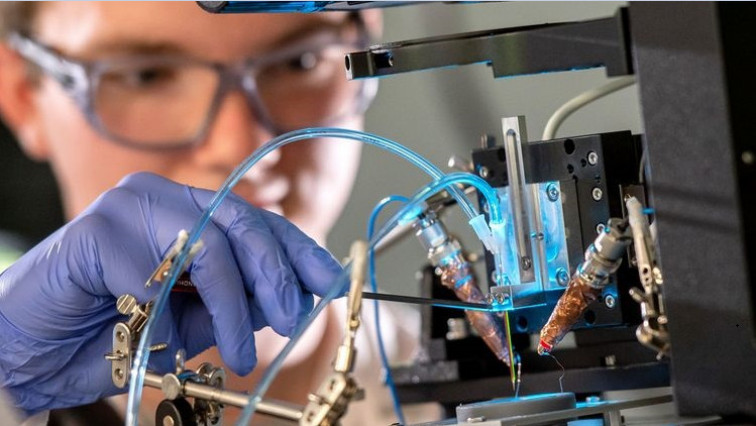It takes chemist Liaisan Khasanova less than a minute to turn an ordinary silica glass tube into a printing nozzle for a special 3D printer. The chemist inserts the 1mm-thick capillary tube into a blue device, closes the flap and presses a button. After a few seconds there is a loud bang and the nozzle is ready for use.
“A laser beam inside the device heats up the tube and pulls it apart. Then we suddenly increase the tensile force so that the glass breaks in the middle and a very sharp tip forms,” said Khasanova, who is working on her Ph.D. in chemistry in Oldenburg’s Electrochemical Nanotechnology Group.
Khasanova and her colleagues need the minuscule nozzles to print incredibly tiny three-dimensional metallic structures. This means the nozzles' openings must be equally tiny—in some cases so small that only a single molecule can pass through.
Nano-scale 3D printing
Dr. Dmitry Momotenko, who leads the junior research group at the Institute of Chemistry, commented, “We are trying to take 3D printing to its technological limits. We want to assemble objects atom by atom.”
Nanoscale 3D printing opens up “amazing opportunities”, the chemist added. For metal objects in particular, he can envisage numerous applications in areas such as microelectronics, nanorobotics, sensor and battery technology. “Electroconductive materials are needed for all kinds of applications in these areas, so metals are the perfect solution,” he said.
While 3D printing of plastics has already advanced into these nanoscale dimensions, manufacturing tiny metal objects using 3D technology has proven more difficult. With some techniques the printed structures are still a thousand times too large for many advanced applications, while with others it is impossible to fabricate the objects with the necessary degree of purity.
Dr. Momotenko specializes in electro-plating. “A liquid salt solution becomes a solid metal—a process which we electrochemists can control very effectively,” he said. Transferring this method to the nanoscopic scale requires considerable ingenuity. The group's small laboratory on the Wechloy campus confirms. The lab contains three printers, in which the key components are smaller than in conventional 3D printing systems.
Battery potential
In printing tests, the Oldenburg researchers have successfully created columns – the simplest geometric forms generated in 3D printing; they can also print spirals, rings and all kinds of overhanging structures. The technique can currently be used to print with copper, silver and nickel, as well as nickel-manganese and nickel-cobalt alloys.
In some of their experiments, they have already ventured deep into the nanoworld. Momotenko and an international team of researchers reported in Nano Letters (2021) that they had produced copper columns with a diameter of just 25 nm — taking 3D metal printing below the 100nm limit for the first time.
Dr. Momotenko’s plans for his nanoprinting technique include laying the foundations for batteries that can be charged a thousand times faster than current models. “If that can be achieved, you could charge an e-car within seconds,” he said.
The basic idea he is pursuing is already around 20 years old. The principle is to drastically shorten the pathways of the ions inside the battery during the charging process. To do this, the electrodes, which are currently flat, would have to have a three-dimensional surface structure.
In his NANO-3D-LION project, the goal is to develop and employ advanced nanoscale 3D printing techniques to fabricate active battery materials with ultrasmall structural features.
Read the original article on Optics.







